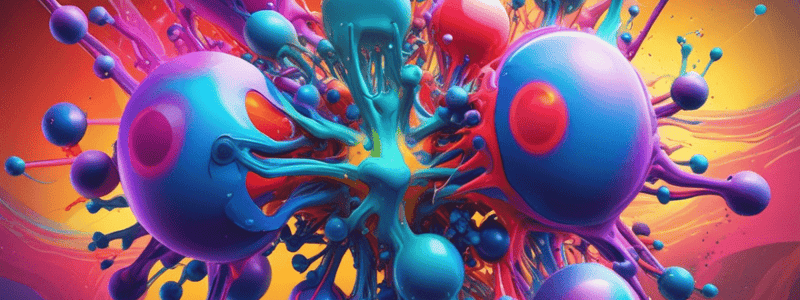Podcast
Questions and Answers
What is the primary mechanism of adhesion between an adhesive and an adherend?
What is the primary mechanism of adhesion between an adhesive and an adherend?
- Diffusion of polymer chains across the interface
- Adsorption through chemical bonding (correct)
- Electrostatic attraction due to electrical double layers
- Mechanical interlocking
Which type of adhesion involves the interlocking of the adhesive with irregularities on the surface of the adherend?
Which type of adhesion involves the interlocking of the adhesive with irregularities on the surface of the adherend?
- Adsorption adhesion
- Chemical bonding
- Diffusion adhesion
- Mechanical adhesion (correct)
What is the weakest type of bonding involved in adhesion?
What is the weakest type of bonding involved in adhesion?
- Physical bonding (correct)
- Covalent bonding
- Ionic bonding
- Hydrogen bonding
Which type of adhesion involves the interlocking of mobile molecules across an interface?
Which type of adhesion involves the interlocking of mobile molecules across an interface?
In which type of adhesion does an electrical double layer contribute to the bonding mechanism?
In which type of adhesion does an electrical double layer contribute to the bonding mechanism?
What type of bonding is involved when surfaces are smooth and there is no chemical interaction between the adhesive and adherend?
What type of bonding is involved when surfaces are smooth and there is no chemical interaction between the adhesive and adherend?
What is the purpose of resin tags formed in the enamel tissue?
What is the purpose of resin tags formed in the enamel tissue?
What is the difference between macrotags and microtags in the enamel tissue?
What is the difference between macrotags and microtags in the enamel tissue?
What is the purpose of etching the enamel and dentin tissues?
What is the purpose of etching the enamel and dentin tissues?
What is the purpose of the smear layer on the cut surfaces of enamel and dentin?
What is the purpose of the smear layer on the cut surfaces of enamel and dentin?
What is the difference between the Type I, Type II, and Type III etching patterns on the enamel tissue?
What is the difference between the Type I, Type II, and Type III etching patterns on the enamel tissue?
What is the relationship between the dentinal tubules and the odontoblastic processes in the dentin tissue?
What is the relationship between the dentinal tubules and the odontoblastic processes in the dentin tissue?
What is the primary basis of dental adhesion?
What is the primary basis of dental adhesion?
What is the ideal contact angle for good wetting of a surface?
What is the ideal contact angle for good wetting of a surface?
What property of an adhesive is important for it to be effective?
What property of an adhesive is important for it to be effective?
What process increases the surface free energy of enamel, aiding adhesion?
What process increases the surface free energy of enamel, aiding adhesion?
What is the purpose of etching enamel with phosphoric acid?
What is the purpose of etching enamel with phosphoric acid?
What is the mechanism by which resin-based materials adhere to etched enamel?
What is the mechanism by which resin-based materials adhere to etched enamel?
What is the primary purpose of dentin etching?
What is the primary purpose of dentin etching?
What factor influences the depth of dentin demineralization during etching?
What factor influences the depth of dentin demineralization during etching?
What is the recommended procedure for drying dentin tissue before bonding?
What is the recommended procedure for drying dentin tissue before bonding?
What type of dentin is more resistant to etching and may result in less penetration of adhesive resin?
What type of dentin is more resistant to etching and may result in less penetration of adhesive resin?
What happens to the peritubular dentin in sclerotic dentin?
What happens to the peritubular dentin in sclerotic dentin?
Flashcards are hidden until you start studying




